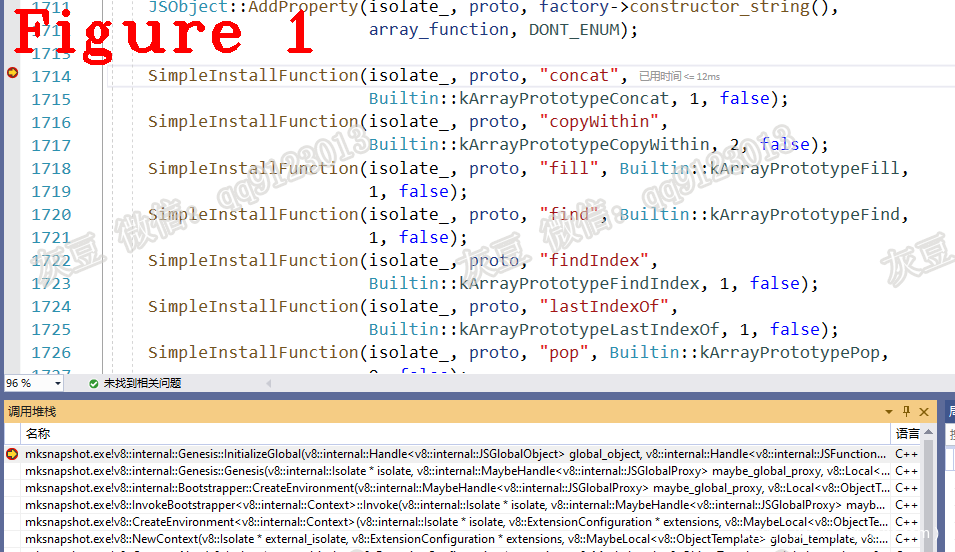1 介绍
substring、getDate、catch 等是常用的 JavaScript API。接下来的几篇文章将从整体上对 JavaScript API 的设计思想、源码和关键函数进行讲解,并能通过例子来分析 JavaScript 在 V8 中的初始化、运行方式,以及它与解释器、编译器、字节码之间的关系。
JavaScript API 的初始化
在 V8 中,JavaScript API(以下简称:API)的初始化由 IniitializeGlobal() 方法负责,该方法在创建 snapshot 时被调用以完成所有 API的初始化,通过调试 mksnapshot 解决方案(VS 2019)可以看到该函数的运行过程,源码如下:
1. void Genesis::InitializeGlobal(Handle<JSGlobalObject> global_object,
2. Handle<JSFunction> empty_function) {
3. Handle<JSFunction> array_prototype_to_string_fun;
4. // 省略...............
5. SimpleInstallFunction(isolate_, array_function, "isArray",
6. Builtin::kArrayIsArray, 1, true);
7. SimpleInstallFunction(isolate_, array_function, "from", Builtin::kArrayFrom,
8. 1, false);
9. SimpleInstallFunction(isolate_, array_function, "of", Builtin::kArrayOf, 0,
10. false);
11. JSObject::AddProperty(isolate_, proto, factory->constructor_string(),
12. array_function, DONT_ENUM);
13. SimpleInstallFunction(isolate_, proto, "concat",
14. Builtin::kArrayPrototypeConcat, 1, false);
15. SimpleInstallFunction(isolate_, proto, "copyWithin",
16. Builtin::kArrayPrototypeCopyWithin, 2, false);
17. SimpleInstallFunction(isolate_, proto, "reverse",
18. Builtin::kArrayPrototypeReverse, 0, false);
19. SimpleInstallFunction(isolate_, proto, "shift",
20. Builtin::kArrayPrototypeShift, 0, false);
21. SimpleInstallFunction(isolate_, proto, "unshift",
22. Builtin::kArrayPrototypeUnshift, 1, false);
23. SimpleInstallFunction(isolate_, proto, "slice",
24. Builtin::kArrayPrototypeSlice, 2, false);
25. // 省略...............
26. }}
通过上述代码可以看到 SimpleInstallFunction() 每执行一次安装一个 API 到 isolate_ 中。以第 13 行为例,参数 “concat” 是字符串,参数 Builtin::kArrayPrototypeConcat 是枚举值,SimpleInstallFunction() 为二者建立了对应关系,当我们在 JavaScript 源码中使用 array.concat 方法时,就是使用对应的 Builtin 方法。下面讲解 SimpleInstallFunction 如何为”concat” 和 Builtin::kArrayPrototypeConcat 建立对应关系,源码如下:
1. V8_NOINLINE Handle<JSFunction> SimpleInstallFunction(
2. Isolate* isolate, Handle<JSObject> base, const char* name, Builtin call,
3. int len, bool adapt, PropertyAttributes attrs = DONT_ENUM) {
4. Handle<String> internalized_name =
5. isolate->factory()->InternalizeUtf8String(name);
6. Handle<JSFunction> fun =
7. SimpleCreateFunction(isolate, internalized_name, call, len, adapt);
8. JSObject::AddProperty(isolate, base, internalized_name, fun, attrs);
9. return fun;
10. }
上述代码中,第 4 行创建 V8 内部字符串 internalized_name,它的值是 “concat”;
第 6 行创建 JSFcunction 方法 fun,把 internalized_name 填充到 fun 内部的 SharedFunction 中,该 JSFunction 的功能是 Builtin::kArrayPrototypeConcat;
第 8 行把 fun 填充进 JSOBject 的属性中。
下面讲解 InternalizeUtf8String() 方法,源码如下:
1. Handle<String> Factory::InternalizeUtf8String(
2. const base::Vector<const char>& string) {
3. base::Vector<const uint8_t> utf8_data =
4. base::Vector<const uint8_t>::cast(string);
5. Utf8Decoder decoder(utf8_data);
6. if (decoder.is_ascii()) return InternalizeString(utf8_data);
7. if (decoder.is_one_byte()) {
8. std::unique_ptr<uint8_t[]> buffer(new uint8_t[decoder.utf16_length()]);
9. decoder.Decode(buffer.get(), utf8_data);
10. return InternalizeString(
11. base::Vector<const uint8_t>(buffer.get(), decoder.utf16_length()));
12. }
13. std::unique_ptr<uint16_t[]> buffer(new uint16_t[decoder.utf16_length()]);
14. decoder.Decode(buffer.get(), utf8_data);
15. return InternalizeString(
16. base::Vector<const base::uc16>(buffer.get(), decoder.utf16_length()));
17. }
上述代码创建 V8 内部字符串,该字符串的类型是InternalzieString,它与 ConsString、OneByteString 等类型的区别是:ConsString 等是 JavaScript 字符串在 V8 中的不同实现,InternalzieString 被用于表达 V8 的基础组件,正如我们现在所说的 “concat”,它是内部字符串,它用于表达一个 SharedFuncion。
上述代码判断字符串 “concat” 的类型是 ASCII、one_byte 或是 two_byte,创建相应的内部符串,并使用 StringTable 缓存以备后面复用。
下面讲解 SimpleCreateFunction() 方法,源码如下:
1. V8_NOINLINE Handle<JSFunction> SimpleCreateFunction(Isolate* isolate,
2. Handle<String> name,
3. Builtin call, int len,
4. bool adapt) {
5. name = String::Flatten(isolate, name, AllocationType::kOld);
6. Handle<JSFunction> fun =
7. CreateFunctionForBuiltinWithoutPrototype(isolate, name, call);
8. JSObject::MakePrototypesFast(fun, kStartAtReceiver, isolate);
9. fun->shared().set_native(true);
10. if (adapt) {
11. fun->shared().set_internal_formal_parameter_count(JSParameterCount(len));
12. } else {
13. fun->shared().DontAdaptArguments();
14. }
15. fun->shared().set_length(len);
16. return fun;
17. }
上述代码中,参数 name、len、adapt 在 InitializeGlobal() 中规定好了。
第 5 行使用 Flatten 创建简单字符串,本文中的 “concat” 已经是简单字符串;
第 6 行创建 JSFunction,此时的 JSFuncion 还没有被安装到 JSObject 上;
第 10~15 行创建 Builtin call 的参数,这些参数设置在 SharedFunction 中。
CreateFunctionForBuiltinWithoutPrototype() 方法使用 NewSharedFunctionInfo() 创建 SharedFunction,NewSharedFunctionInfo()源码如下:
1. Handle<SharedFunctionInfo> FactoryBase<Impl>::NewSharedFunctionInfo(
2. MaybeHandle<String> maybe_name, MaybeHandle<HeapObject> maybe_function_data,
3. Builtin builtin, FunctionKind kind) {
4. Handle<SharedFunctionInfo> shared = NewSharedFunctionInfo();
5. DisallowGarbageCollection no_gc;
6. SharedFunctionInfo raw = *shared;
7. Handle<String> shared_name;
8. bool has_shared_name = maybe_name.ToHandle(&shared_name);
9. if (has_shared_name) {
10. DCHECK(shared_name->IsFlat());
11. raw.set_name_or_scope_info(*shared_name, kReleaseStore);
12. } else {
13. DCHECK_EQ(raw.name_or_scope_info(kAcquireLoad),
14. SharedFunctionInfo::kNoSharedNameSentinel);
15. }
16. Handle<HeapObject> function_data;
17. if (maybe_function_data.ToHandle(&function_data)) {
18. DCHECK(!Builtins::IsBuiltinId(builtin));
19. DCHECK_IMPLIES(function_data->IsCode(),
20. !Code::cast(*function_data).is_builtin());
21. raw.set_function_data(*function_data, kReleaseStore);
22. } else if (Builtins::IsBuiltinId(builtin)) {
23. raw.set_builtin_id(builtin);
24. } else {
25. DCHECK(raw.HasBuiltinId());
26. DCHECK_EQ(Builtin::kIllegal, raw.builtin_id());
27. }
28. raw.CalculateConstructAsBuiltin();
29. raw.set_kind(kind);
30. return shared;
31. }
上述代码中,第 2 行参数 maybe_name 是 ‘concat’,参数 builtin 是 Builtin::kArrayPrototypeConcat;
第 4 行创建 SharedFunctionInfo shared;
第 7-15 行把 ‘concat’ 填充进 shared;
第 17-29 行验证 Builtin::kArrayPrototypeConcat 的值是否正确,并将其设置到 shared 中。
下面讲解 MakePrototypesFast() 方法,源码如下:
1. void JSObject::MakePrototypesFast(Handle<Object> receiver,
2. WhereToStart where_to_start,
3. Isolate* isolate) {
4. if (!receiver->IsJSReceiver()) return;
5. for (PrototypeIterator iter(isolate, Handle<JSReceiver>::cast(receiver),
6. where_to_start);
7. !iter.IsAtEnd(); iter.Advance()) {
8. Handle<Object> current = PrototypeIterator::GetCurrent(iter);
9. if (!current->IsJSObject()) return;
10. Handle<JSObject> current_obj = Handle<JSObject>::cast(current);
11. Map current_map = current_obj->map();
12. if (current_map.is_prototype_map()) {
13. // If the map is already marked as should be fast, we're done. Its
14. // prototypes will have been marked already as well.
15. if (current_map.should_be_fast_prototype_map()) return;
16. Handle<Map> map(current_map, isolate);
17. Map::SetShouldBeFastPrototypeMap(map, true, isolate);
18. JSObject::OptimizeAsPrototype(current_obj);
19. }
20. }
21. }
上述代码通过循环迭代的方式查找相应的 prototype 并设置好 map。图 1 给出了此时的调用堆栈。
3.JavaScript API 的使用方法
上面从 V8 源码的角度讲解了从 Builtin::kArrayPrototypeConcat 到 JSFuncion 的创建。下面从 JavaScript 源码的角度讲解 Builtin::kArrayPrototypeConcat 的使用方法。测试代码如下:
1. 1. var a=[1,2,3];
2. 2. var b=[4,5,6];
3. var c= a.concat(b);
4. console.log(c);
5. //分隔线..........................
6. Bytecode Age: 0
7. //省略...........................
8. 00000159B6561FCA @ 28 : c1 Star2
9. 00000159B6561FCB @ 29 : 2d f8 05 08 LdaNamedProperty r2, [5], [8]
10. 00000159B6561FCF @ 33 : c2 Star1
11. 00000159B6561FD0 @ 34 : 21 04 0a LdaGlobal [4], [10]
12. 00000159B6561FD3 @ 37 : c0 Star3
13. 00000159B6561FD4 @ 38 : 5d f9 f8 f7 0c CallProperty1 r1, r2, r3, [12]
14. 00000159B6561FD9 @ 43 : 23 06 0e StaGlobal [6], [14]
15. 00000159B6561FDC @ 46 : 21 07 10 LdaGlobal [7], [16]
16. 00000159B6561FDF @ 49 : c1 Star2
17. 00000159B6561FE0 @ 50 : 2d f8 08 12 LdaNamedProperty r2, [8], [18]
18. 00000159B6561FE4 @ 54 : c2 Star1
19. 00000159B6561FE5 @ 55 : 21 06 14 LdaGlobal [6], [20]
20. 00000159B6561FE8 @ 58 : c0 Star3
21. 00000159B6561FE9 @ 59 : 5d f9 f8 f7 16 CallProperty1 r1, r2, r3, [22]
22. 00000159B6561FEE @ 64 : c3 Star0
23. 00000159B6561FEF @ 65 : a8 Return
上述代码中,第 9 行代码加载数组的属性 concat;在本例中,字节码 LdaNamedProperty 的作用是通过字符串 ‘concat’ 加载对应的 JSFunction 方法。
第 13 行代码调用该函数 JSFunction。
字节码由 JavaScript 源码编译并生成,’concat’ 在字节码中保存为常量,该常量是 JavaScript 源码到 JSFuncion 的唯一联系。
后续的几篇文章将会讲解 JavaScript API 的调用过程。
技术总结
(1) JavaScript API 以 Builtins 形式存在 V8中;
(2) 在 V8 中使用 SharedFuncion 保存 API,并保存在 JSObject 属性中;
(3) JavaScript 源码中使用的 API 在字节码中被保存为常量字符串,在使用之前利用 LdaNamedProperty 加载相应的 JSFunction。
好了,今天到这里,下次见。
个人能力有限,有不足与纰漏,欢迎批评指正
微信:qq9123013 备注:v8交流 邮箱:v8blink@outlook.com
《Chrome V8 源码》 搬家啦
各位读者,新年好!
(1) 《Chrome V8 源码》以后不在安全客发表了。新家正在装修中,请各位关注我的知乎和微信(在下方),文章发表后会转载到知乎。预计 10 天后发表新的文章,届时会在知乎上说明新家的位置。
(2) 视频课程即将上线,请关注我的知乎,期待您的光临。
知乎: https://www.zhihu.com/people/v8blink
微信: qq9123013
感谢各位读者对我的支持,谢谢!
感谢安全客、感谢小安!
祝大家虎年大吉、虎虎生威!










发表评论
您还未登录,请先登录。
登录